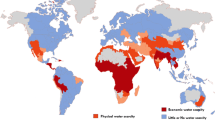Abstract
This paper introduces the conjunctive use of a deterministic water quality model and water balance criteria for supporting the assessment of simulation and to evaluate the effectiveness of proposed operation strategies. By this, the applicability of enhanced reservoir operation strategies addressing both water quality as well as water quantity aspects under water deficit conditions in dry years can be shown. Arguments will be developed to address stakeholders and decision makers in the context of a more conservative past operation regime. Results are presented for the Kaparas reservoir, which is located in the lower Amu Darya River, on the border of Turkmenistan and Uzbekistan. As being one out of four large reservoirs of the Tuyamuyun Hydro Complex (THC), the Kaparas reservoir could be increasingly used for drinking water supply for the lower Amu Darya region. The results for the dry year 2001 indicates that the combination of simulation together with practical assessment criteria confirm the applicability of adapted operation rules for THC reservoirs and ways can be found to supply the local population (of the lower Amu Darya region) with more potable water of higher quality even subject to a parallel reduction of water deficits. Future aggravation of water stress due to increasing population growth and water quality deterioration will require a more comprehensive consideration of water quality aspects in many arid and semi arid regions. The experience gained during this study emphasizes the fact that classical deterministic water quality models provide effective tools to address even more complex water quality problems under water stressed conditions, provided processing of results is performed, to support the decision making process.
Similar content being viewed by others
References
Arnold U, Orlob GT (1989) Decision support for estuarine water quality management. J Water Resour Plan Manage 115(6):775–792. doi:10.1061/(ASCE)0733–9496(1989)115:6(775)
Bloss S, Harleman DRF (1980) Effects of wind induced mixing on the seasonal thermocline in lakes and reservoirs. In: Carstens T, McClimans T (ed) Second international symposium on stratified flows, vol I. Trondheim, Norway, pp 291–300
Chaves P, Kojiri T, Yamashiki Y (2003) Optimization of storage reservoir considering water quantity and quality. Hydrol Process 17:2769–2793. doi:10.1002/hyp.1433
Croke BFW, Ticehurst JL et al (2007) Integrated assessment of water resources: Australian experiences. Water Resour Manage 21(1):351–373. doi:10.1007/s11269-006-9057-8
Crosa G, Froebrich J, Nikolayenko V, Stefani F, Galli P, Calamari D (2006) Spatial and seasonal variations in the water quality of the Amu Darya river. Water Res 40:2237–2245. doi:10.1016/j.watres.2006.04.004
Dandy G, Crawley P (1992) Optimum operation of a multiple reservoir system including salinity effects. Water Resour Res 28(4):979–990. doi:10.1029/91WR02687
Ewing T, Romero JR, Imberger J, Antenucci J, Deen A (2004) A real-time reservoir decision support system. In: Liong S-Y, Phoon K-K, Babovic V (eds) 6th international conference on hydroinformatics, vol 2. World Scientific, Singapore, pp 1123–1131
Findikakis A, Law AWK (1999) Wind mixing in temperature simulations for lakes and reservoirs. J Environ Eng 125(5):420–428. doi:10.1061/(ASCE)0733-9372(1999)125:5(420)
Froebrich J (2000) Vorhersage der mehrjährigen Wassergüteentwicklung in Speichern mittels eines deterministischen Modells. (Prognosis of water quality dynamics in reservoirs by use of a deterministic model). Dissertation, University of Hannover, Cuvillier Verlag Goettingen
Hurley Octavio KA, Jirka GH, Harleman DRF (1977) Vertical heat transport mechanisms in lakes and reservoirs. Report No. 227. R. M. Parsons Laboratory for Water Resources and Hydrodynamics, Department of Civil Engineering, Massachusetts Institute of Technology
Hydrological Engineering Center (1974) WQRRS, generalized computer program for river-reservoir systems. In: User’s manual 401–100, 100A US Army Corps of Engineers, HEC. Davis, CA
Imberger J, Patterson J, Bebbert B, Loh I (1978) Dynamics of reservoir of medium size. J Hydraulic Div 104:725–743
Imboden DM, Wuest A (1995) Mixing mechanisms in lakes. In: Lerman A et al (eds) Physics and chemistry of lakes. Springer, Berlin, pp 84–138
Kayumov O, Ikramova MR (1997) Influence of Tuyamuyun Hydrosystem on bed processes and water intake in Amu Darya lowers. Uzbekistan Agriculture, (2), Tashkent
Lehmann H, Lehmann F (Retenue de Sidi Salem) (2000) Modélisation du bilan d’oxygène. Continuation, complément et intégration de la modélisation. Rapport final on behalf of GTZ, Projet GeORE (Gestion optimale des ressources en eau, PN 99.5621.0, Institut für Wassergüte und Umweltschutz (IFWU), Hannover.
Muhammetoglu A, Muhammetoglu H, Oktas S, Ozgokcen L, Soyupak S (2005) Impact assessment of different management scenarios on water quality of porsuk river and dam system—Turkey. Water Resour Manage 19:199–210. doi:10.1007/s11269-005-3473-z
Orlob GT (1983) One-dimensional models for simulation of water quality in lakes and reservoirs. In: Orlob GT (ed) Mathematical modelling of water quality in streams, lakes and reservoirs. Wiley, Chichester
Paredes J, Lund JR (2006) Refill and drawdown rules for parallel reservoirs: quantity and quality. Water Resour Manage 20:359–376. doi:10.1007/s11269-006-0325-4
Shiau JT (2003) Water release policy effects on the shortage characteristics for the Shihmen Reservoir system during droughts. Water Resour Manage 17(6):463–480. doi:10.1023/B:WARM.0000004958.93250.8a
Sorokin A, Ikramova M (2005) Modelling studies tuyamuyun hydro complex model. IWMT ‘Development of integrated water management tools for the Tuyamuyun reservoir complex—improvement of drinking water supply and public health in the disaster zone of lower Amu Darya’, Final Report EU-INTAS 1043/DFG 1607/FR1-1
World Health Organization (2004) WHO Guidelines for drinking-water quality, 3rd edn. World Health Organization (WHO), Geneva, p 515
Yevjevich V (1967) An objective approach to definitions and investigations of continental hydrologic droughts. Hydrology Paper No.23. Colorado State Univ., Fort Collins
Author information
Authors and Affiliations
Corresponding author
Rights and permissions
About this article
Cite this article
Olsson, O., Ikramova, M., Bauer, M. et al. Applicability of Adapted Reservoir Operation for Water Stress Mitigation Under Dry Year Conditions. Water Resour Manage 24, 277–297 (2010). https://doi.org/10.1007/s11269-009-9446-x
Received:
Accepted:
Published:
Issue Date:
DOI: https://doi.org/10.1007/s11269-009-9446-x




